 W
WA province is the second largest administrative division in Chile with 56 in total. The largest administrative division in Chile is that of a region with 16 in total.
 W
WAisén Province is one of four provinces of the Chilean region of Aisen (XI). Its capital is Puerto Aisén.
 W
WAntártica Chilena Province is the southernmost and one of four provinces in Chile's southernmost region, Magallanes and Antártica Chilena Region (XII). The capital is Puerto Williams. The province comprises the extreme southern part of Isla Grande de Tierra del Fuego, the islands south and west of Isla Grande, and Chile's claims in Antarctica. The province is administratively divided into two communes (comunas): Cabo de Hornos, located at the southern tip of South America, and Antártica, a wedge-shaped claim of Antarctica, which is not internationally recognized. Its total area of 1,265,853.7 km2 (488,749 sq mi) makes it almost twice as large as all other provinces of Chile combined.
 W
WAntofagasta Province is one of three provinces in the northern Chilean region of Antofagasta (II). The capital is the port city of Antofagasta. Located within the Atacama Desert, it borders the El Loa and Tocopilla provinces to the north, the Pacific Ocean to the West and the Atacama Region to the south.
 W
WArauco Province is one of four provinces of the Chilean region of Bío Bío (VIII). It spans a coastal area of 6,366 km2 (2,458 sq mi) just south of the mouth of the Biobío River, the traditional demarcation between the nation's major natural regions, Zona Central and Zona Sur. The province originally covered the once-independent indigenous territory of Araucanía, but this was afterward divided into four provinces. It is devoted largely to agricultural pursuits. The capital Lebu is situated on the coast about 90 km (56 mi) south of Concepción with which it is connected by rail.
 W
WArica Province is one of two provinces of Chile's northernmost region, Arica y Parinacota. The province is bordered on the north by the Tacna Province of Peru, on the south by the Tamarugal Province in the Tarapacá Region, on the east the Parinacota Province and on the west by the Pacific Ocean. Its capital is the port city of Arica.
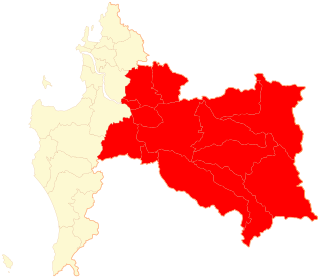 W
WBiobío Province is one of four provinces of the Chilean region of Biobío (VIII). Its capital is Los Ángeles. It is bounded on the north, west and south by the provinces of Concepción, Arauco and Malleco, respectively, and on the east by Argentina. It has an area of 14,987.9 km2 (5,787 sq mi) of well-wooded and mountainous country, and exports timber to a large extent. The population is 373,981 according to the census of 2012.
 W
WCachapoal Province is one of three provinces of the central Chilean region of O'Higgins (VI). Its capital is the city of Rancagua.
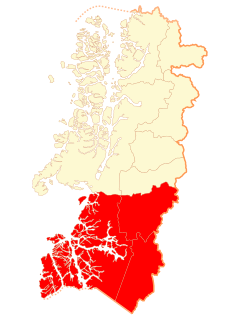 W
WCapitán Prat Province is one of four provinces in the southern Chilean region of Aisén (XI). Its capital is Cochrane. The province is named after the naval hero Arturo Prat.
 W
WCardenal Caro Province is one of the three provinces of the central Chilean region of O'Higgins (VI). The capital of Cardenal Caro is Pichilemu.
 W
WCauquenes Province is one of four provinces of the central Chilean region of Maule (VII). The provincial capital is the city of Cauquenes.
 W
WCautín Province is one of two provinces in the southern Chilean region of La Araucanía (IX), bounded on the north by Arauco and Malleco provinces, on the east by Argentina, on the south by Valdivia Province, and on the west by the Pacific Ocean. Its population at the 2012 census was of 692,582. The most important communes are Temuco, Villarrica, Padre Las Casas, and Nueva Imperial. Cattle, forestry, and agriculture make up most of Cautin's economy. Its climate is humid, rainy in winter, and generally warm in summer.
 W
WChacabuco Province is one of six provinces of the Santiago Metropolitan Region in central Chile. It is located north of the Province of Santiago, which is entirely urbanized and part of the Santiago conurbation. The provincial capital, Colina, lies approximately 27 km (17 mi) north of Santiago.
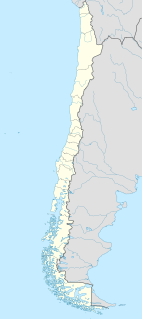 W
WChañaral Province is one of three provinces in the northern Chilean region of Atacama (III). Its capital is the small coastal town of Chañaral.
 W
WChiloé Province is one of the four provinces in the southern Chilean region of Los Lagos (X). It consists of all of Chiloé Archipelago with the exception of the Desertores Islands. The province spans a surface area of 9,181.6 km2 (3,545 sq mi). Its capital is Castro, and the seat of the Roman Catholic bishopric is Ancud.
 W
WChoapa Province is one of the provinces making up the Coquimbo Region of Chile. It has an area of 10,079.8 km² and a population of 81,681. The capital of the province is the town of Illapel. The current governor is Gisella Mateluna Gambo.
 W
WValle Colchagua is in Chile
 W
WConcepción Province is one of four provinces of the Chilean region of Bío Bío (VIII). Its capital, Concepción, is part of the Greater Concepción conurbation, the nation's second largest metropolitan area after Santiago.
 W
WCopiapó Province is one of three provinces of the northern Chilean region of Atacama (III). Its capital is the city of Copiapó.
 W
WCordillera Province is one of six provinces in the Santiago Metropolitan Region of central Chile. Its topography includes a small area of Chile's central valley, glaciers, rivers, volcanoes, and the Andes range, which forms the border with Mendoza Province in Argentina. The provincial capital of Puente Alto lies approximately 21 km (13 mi) south-southeast of Santiago.
 W
WCoyhaique Province is one of four provinces of the southern Chilean region of Aisen (XI). Its capital city is Coyhaique. It is the most populous of provinces in the Aysén Region.
 W
WCuricó Province is one of four provinces of the central Chilean region of Maule (VII). Its capital is the city of Curicó. It lies between the provinces of Colchagua and Talca and extends from the Pacific to the Argentine frontier, spanning an area of 7,280.9 km2 (2,811 sq mi). According to the 2002 census, the population was 244,053.
 W
WThe Diguillín Province is the biggest of the three provinces of the Ñuble Region.
 W
WEaster Island is an island and special territory of Chile in the southeastern Pacific Ocean, at the southeasternmost point of the Polynesian Triangle in Oceania. Easter Island is most famous for its nearly 1,000 extant monumental statues, called moai, created by the early Rapa Nui people. In 1995, UNESCO named Easter Island a World Heritage Site, with much of the island protected within Rapa Nui National Park.
 W
WEl Loa Province is one of three provinces of the northern Chilean region of Antofagasta (II). It is named after the longest of rivers in Chile, the Loa River. The provincial capital is Calama.
 W
WEl Ranco Province is one of two provinces of the southern Chilean region of Los Ríos (XIV). It is named after Ranco Lake shared by the communes (comunas) of Futrono and Lago Ranco. The lake is drained by the Bueno River, on which basin lies most of the province. La Unión is the provincial capital.
 W
WElqui Province is a province in the Chilean region of Coquimbo (IV). The provincial capital is the city of Coquimbo.
 W
WGeneral Carrera Province is one of four provinces of the southern Chilean region of Aisen (XI). Its capital city is Chile Chico.
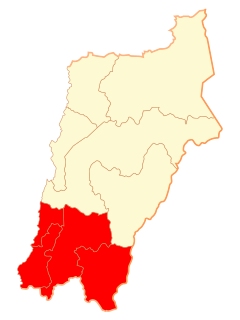 W
WHuasco Province is one of three provinces of the northern Chilean region of Atacama (III). Vallenar is the capital city.
 W
WIquique Province is one of two provinces in the northern Chilean region of Tarapacá. Its capital is the port city of Iquique.
 W
WThe Itata Province is one of the three provinces of the Ñuble Region;, its capital is Quirihue.
 W
WLimarí Province is one of three provinces of the Chilean region of Coquimbo Region (IV). Its capital is the city of Ovalle
 W
WLinares is one of four provinces of the central Chilean region of Maule (VII). The provincial capital and most populous center is the city of Linares.
 W
WLlanquihue Province is one of four provinces of the Chilean region of Los Lagos (X). Its capital is Puerto Montt. Chile's second largest lake, Lake Llanquihue, is located in the province as well as four volcanoes: Osorno, Calbuco, Puntiagudo and Cerro Tronador.
 W
WLos Andes Province is one of eight provinces of the central Chilean region of Valparaíso (V). The city of Los Andes is the capital of the province.
 W
WMagallanes Province is one of four provinces in the southern Chilean region of Magallanes and Antártica Chilena. The provincial capital is the city of Punta Arenas.
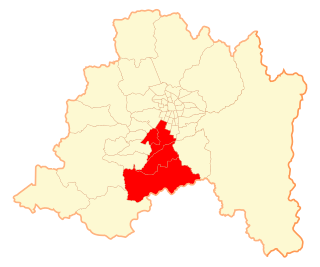 W
WMaipo Province is one of six provinces in the Santiago Metropolitan Region of central Chile. Its capital is San Bernardo.
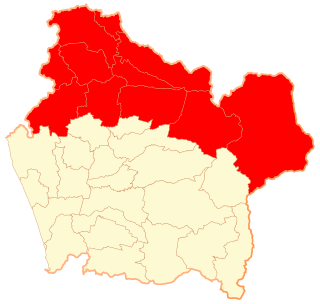 W
WMalleco Province is one of two provinces in the southern Chilean region of La Araucanía (IX). Its population as of the 2017 census is 205,124, and it covers an area of 13,433.3 km2 (5,187 sq mi). The provincial capital is the city of Angol.
 W
WMarga Marga Province is one of the eight provinces in the central Chilean region of Valparaíso (V). Its capital is the city of Quilpué.
 W
WMelipilla Province is one of six provinces in the Santiago Metropolitan Region of central Chile. The provincial capital is the city of Melipilla.
 W
WOsorno Province is one of the four provinces in the southern Chilean region of Los Lagos (X). The province has an area of 9,223.7 km2 (3,561 sq mi) and a population of 221,496 distributed across seven communes. The provincial capital is the city of Osorno.
 W
WPalena Province is the southernmost administrative area in Chile's Los Lagos Region Los Lagos (X). The area is also called Continental Chiloe or Northern Patagonia, as geographers consider the Palena Province to be the starting point of Chilean Patagonia which extends south from Palena all the way to Tierra del Fuego. Palena Province is remote, beautiful, and difficult to access. In fact, Palena is one of the most sparsely populated provinces in the country and features a stunning geography characterized by steep fjords, wild rivers, hot springs, and numerous snow-capped volcanos. Chile's Austral Highway is not continuous through the jagged geography of Palena Province. Motorists accessing the area by car are required to take two ferries across fjords to cross the province.
 W
WParinacota Province is one of two provinces of the Chilean region of Arica y Parinacota. Its capital is Putre. It is named after the Parinacota Volcano.
 W
WPetorca Province is one of eight provinces of the central Chilean region of Valparaíso (V). Its capital is the city of La Ligua.
 W
WPunilla Province is one of the three provinces of the Ñuble Region of Chile
 W
WQuillota Province is one of eight provinces of the central Chilean region of Valparaíso (V). Its capital is the city of Quillota.
 W
WSan Antonio Province is one of eight provinces of the central Chilean region of Valparaíso (V). Its capital is the port city of San Antonio.
 W
WSan Felipe de Aconcagua Province is one of eight provinces of the central Chilean region of Valparaíso (V). Its capital is the city of San Felipe.
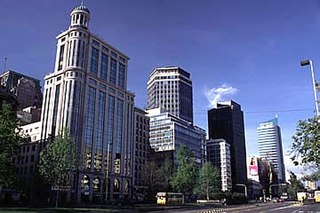 W
WSantiago Province is one of the six provinces of the Santiago Metropolitan Region (RM) of central Chile. It encompasses the majority of the population of that region, including 31 of the 36 communities of Greater Santiago. The province spans 2,030.30 km (1,262 mi).
 W
WTalagante Province is one of six provinces of the Santiago Metropolitan Region in central Chile. The capital is the city of Talagante, located approximately 35 km (22 mi) southwest of the national capital of Santiago. The most northeastern part of the province is included in the Santiago conurbation.
 W
WTalca Province is one of four provinces of the central Chilean region of Maule (VII). Its capital is the city of Talca.
 W
WTamarugal Province is one of two provinces in the northern Chilean region of Tarapacá. The capital is the city of Pozo Almonte.
 W
WTierra del Fuego Province is one of four provinces in the southern Chilean region of Magallanes and Antártica Chilena (XII). It includes the Chilean or western part of the main island of Tierra del Fuego, except for the part south of the Cordillera Darwin, which is in Antártica Chilena Province.
 W
WTocopilla Province is one of the three provinces in the northern Chilean region of Antofagasta (II). Its capital is the city of Tocopilla.
 W
WÚltima Esperanza is one of four provinces in the southern Chilean region of Magallanes and Antártica Chilena (XII). The capital is Puerto Natales and it is named after Última Esperanza Sound. A section of its border with Argentina in the Southern Patagonian Ice Field is under dispute.
 W
WValdivia Province is one of two provinces of the southern Chilean region of Los Ríos (XIV). The provincial capital is Valdivia. Located in the province are two important rivers, the Calle-Calle / Valdivia River and the Cruces River.It is part of Northern Patagonia and its wild virgin forest embrace the Patagonian Cordillera following the river Calle Calle down to the Pacific Ocean. It is known in Patagonia the term "Bosque Valdiviano" referring to the primitive forest of Valdivia with its native trees. These forests are present in some parts of Northern Patagonia, both in Chile and Argentina.
 W
WValparaíso Province is one of eight provinces of the central Chilean region of Valparaíso (V). Its capital is the coastal city of Valparaíso.